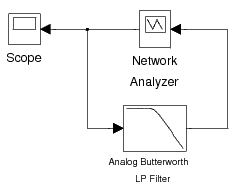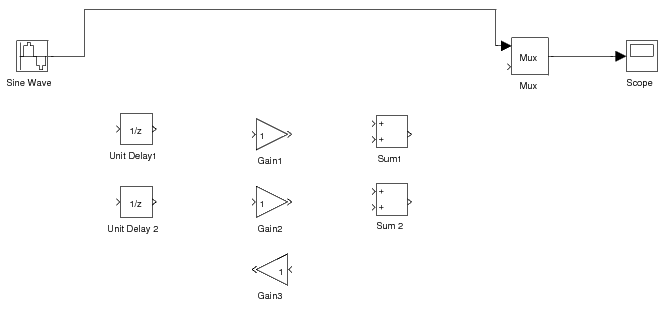| << Chapter < Page | Chapter >> Page > |

Double click the icon labeled
CT System Analysis using a Network Analyzer to bring up a system as shown in
[link] .
This system includes a
Network Analyzer model
for measuring the frequency response of a system.The
Network Analyzer works by generating a weighted
chirp signal (shown on the
Scope )
as an input to the system-under-test.The analyzer measures the frequency response of the input
and output of the system and computes the transfer function.By computing the inverse Fourier transform, it then
computes the impulse response of the system.Use this setup to compute the frequency and impulse
response of the given fourth order Butterworth filter with a cut-offfrequency of 1Hz. Print the figure showing the magnitude response,
the phase response and the impulse response of the system. To use the tallmode to obtain a larger printout, type
orient('tall'); directly before you print.

An alternative method for computing the impulse response is
to input a step into the system and then to compute the derivative
of the output.The model for doing this is given in the
CT System Analysis using a Unit Step block.
Double click on this icon and compute the impulse response of thefilter using this setup (
[link] ).
Make sure that the characteristics of the filterare the same as in the previous setup.
After running the simulation, print the graphof the impulse response.
Network Analyzer (magnitude and phase of the frequency response, and the
impulse response) and the plot of the impulse responseobtained using a unit step.
What are the advantages and disadvantages of each method?In this section of the laboratory, we will study the use of the discrete-time Fourier transform.
The DTFT (Discrete-Time Fourier Transform) is the Fourier representation used for finite energy discrete-time signals.For a discrete-time signal, , we denote the DTFT as the function given by the expression
Since is a periodic function of with a period of , we need only to compute for .
Write a Matlab function
X=DTFT(x,n0,dw) that computes the DTFT
of the discrete-time signal
x Here
n0 is the time index
corresponding to the 1st element of the
x vector, and
dw is the spacing between the samples
of the Matlab vector
X .
For example, if
x is a vector of length
N , then
its DTFT is computed by
where
is a vector of values formed by
w=(-pi:dw:pi) .
j or
i is defined
as
. However, you may also compute this value using
the Matlab expression
i=sqrt(-1) .For the following signals use your DTFT function to
subplot command.abs() and
angle() commands.For help on printing Simulink system windows click here .

Double click the icon labeled
DT System Analysis to bring up an incomplete block diagram as shown in
[link] .
It is for a model that takes a discrete-time sine signal, processesit according to a difference equation
and plots the multiplexed input and output signals in a graph window.Complete this block diagram such that it implements
the following difference equation given in
"Magnitude and Phase of Discrete-Time Systems" of the background exercises.
You are provided with the framework of the setup and
the building blocks that you will need.You can change the values of the
Gain blocks by double clicking on them.
After you complete the setup, adjust the frequency of
Sine Wave to
the following frequencies:
,
, and
.
For each frequency,make magnitude response measurements using
the input and output sequences shown in the graph window.Compare your measurements with the
values of the magnitude response
which you computed
in the background exercises at these frequencies.
An alternative way of finding the frequency response is taking the DTFT
of the impulse response.Use your DTFT function to find the frequency response of this system from
its impulse response. The impulse response was calculated in
"Magnitude and Phase of Discrete-Time Systems" of the background exercises.
Plot the impulse response, andthe magnitude and phase of the frequency response in the same figure
using the
subplot command.

Notification Switch
Would you like to follow the 'Purdue digital signal processing labs (ece 438)' conversation and receive update notifications?